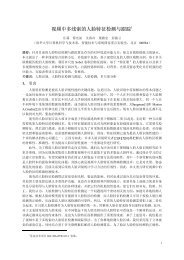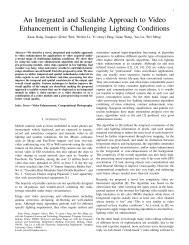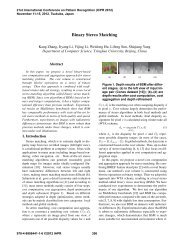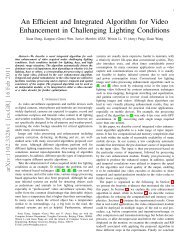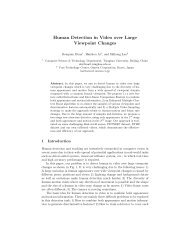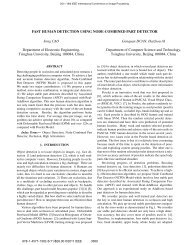Smart Classroom â an Intelligent Environment for distant ... - CiteSeerX
Smart Classroom â an Intelligent Environment for distant ... - CiteSeerX
Smart Classroom â an Intelligent Environment for distant ... - CiteSeerX
You also want an ePaper? Increase the reach of your titles
YUMPU automatically turns print PDFs into web optimized ePapers that Google loves.
could eventually make the right choice.<br />
This also happens to <strong>Smart</strong> <strong>Classroom</strong>. In the scenario we designed, the teacher c<strong>an</strong> use<br />
speech <strong>an</strong>d h<strong>an</strong>d gesture to make <strong>an</strong>notations on the media-board, to m<strong>an</strong>age the content in the<br />
media-board <strong>an</strong>d to control the utter<strong>an</strong>ce right of the remote students.<br />
Currently, some adv<strong>an</strong>ces have been made in the multi-modality processing research. The<br />
most famous approach is the one used in the Quickset project [9]. It essentially takes the<br />
multi-modality integration process as a kind of l<strong>an</strong>guage parsing process, i.e., each separate action<br />
in a single modality is considered as a phrase structure in the multi-modal l<strong>an</strong>guage grammar, they<br />
are grouped <strong>an</strong>d induced to generate a new higher level phrase structure. The process is repeated<br />
until a sem<strong>an</strong>tic completed sentence is found. The process could also help to correct the wrong<br />
recognition result of one modality. If one phrase structure could not be grouped with <strong>an</strong>y other<br />
phrase structure according to the grammar, it will be regarded as a wrong recognition result <strong>an</strong>d<br />
will be ab<strong>an</strong>doned. Although the method is focused on the pen-based computer, it could be used<br />
into the <strong>Intelligent</strong> <strong>Environment</strong> research as well after some modifications.<br />
3.4 Take context into account<br />
In order to determine the exact intention of the user in the <strong>Intelligent</strong> <strong>Environment</strong>, the<br />
context in<strong>for</strong>mation should also be taken into account. For example, in the <strong>Smart</strong> <strong>Classroom</strong>,<br />
when the teacher says “turn to the next page”, dose he me<strong>an</strong>s the courseware displayed on the<br />
media-board should be switched to the next page or just tells the students to turn their textbooks to<br />
the next page? Here the multi-modal integration mech<strong>an</strong>ism could not resolve the ambiguity<br />
because the teacher just says the comm<strong>an</strong>d without <strong>an</strong>y additional gestures. However, we could<br />
easily tell the teacher’s exact intention by recognizing where he st<strong>an</strong>ds <strong>an</strong>d what he faces.<br />
We consider that the context in <strong>an</strong> <strong>Intelligent</strong> <strong>Environment</strong> generally include the following<br />
factors:<br />
1. Who is there?<br />
A natural <strong>an</strong>d sophisticated way to acquire this in<strong>for</strong>mation is through the person’s biology<br />
character, such as face, acoustic, foot print <strong>an</strong>d so on.<br />
2. Where is the person located?<br />
This in<strong>for</strong>mation could be acquired by vision tracking. In order to the result from the vision<br />
tacking module could be interpreted by other modules in the system, a geometric modeling<br />
of the environment is also needed.<br />
3. What are ongoing in the environment?<br />
This in<strong>for</strong>mation including the action the user explicitly takes <strong>an</strong>d others implied in the<br />
user’s behaviors. The <strong>for</strong>mer one could be acquired by multi-modal recognition <strong>an</strong>d<br />
processing. However, there is no <strong>for</strong>mal approach available dealing with the latter problem<br />
indeed using our current AI technologies except some ad-hoc methods.<br />
4 Our approach <strong>an</strong>d current progress<br />
We have currently completed a first-stage demo of the <strong>Smart</strong> <strong>Classroom</strong>. The system is<br />
composed of the following key components.<br />
1. The multi-agent software plat<strong>for</strong>m.<br />
We adopted a public available multi-agent system, OAA (Open Agent Architecture), as<br />
the software plat<strong>for</strong>m <strong>for</strong> the <strong>Smart</strong> <strong>Classroom</strong>. It was developed by SRI <strong>an</strong>d has been used by



